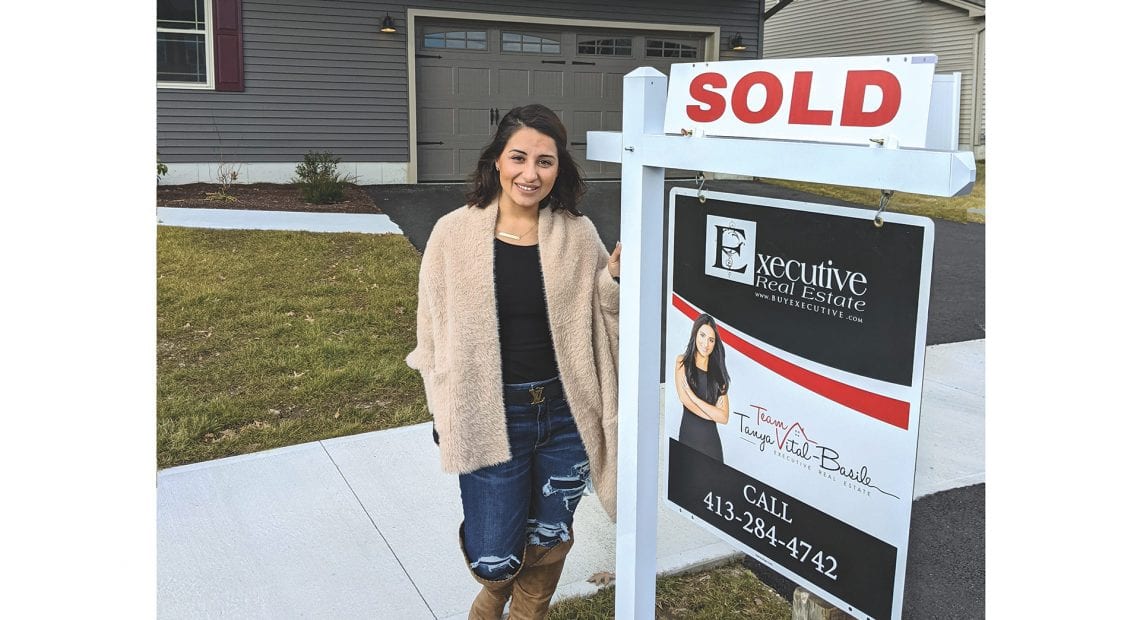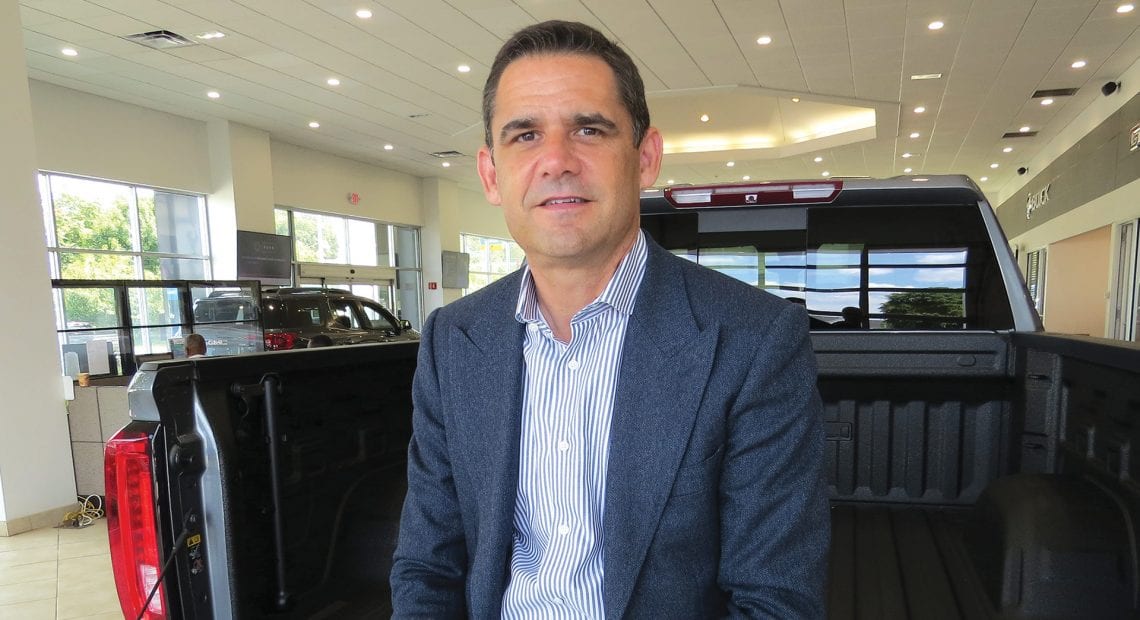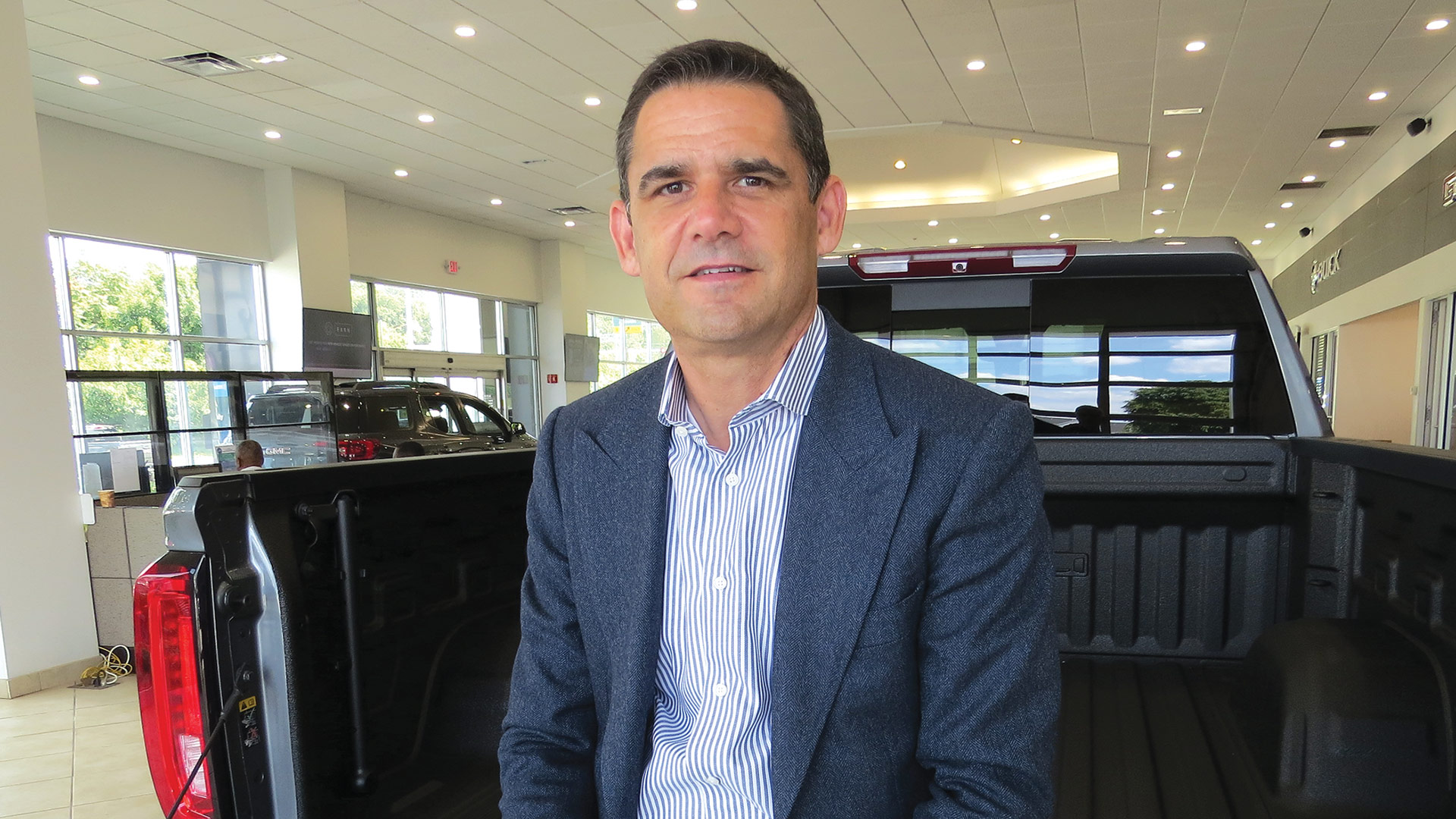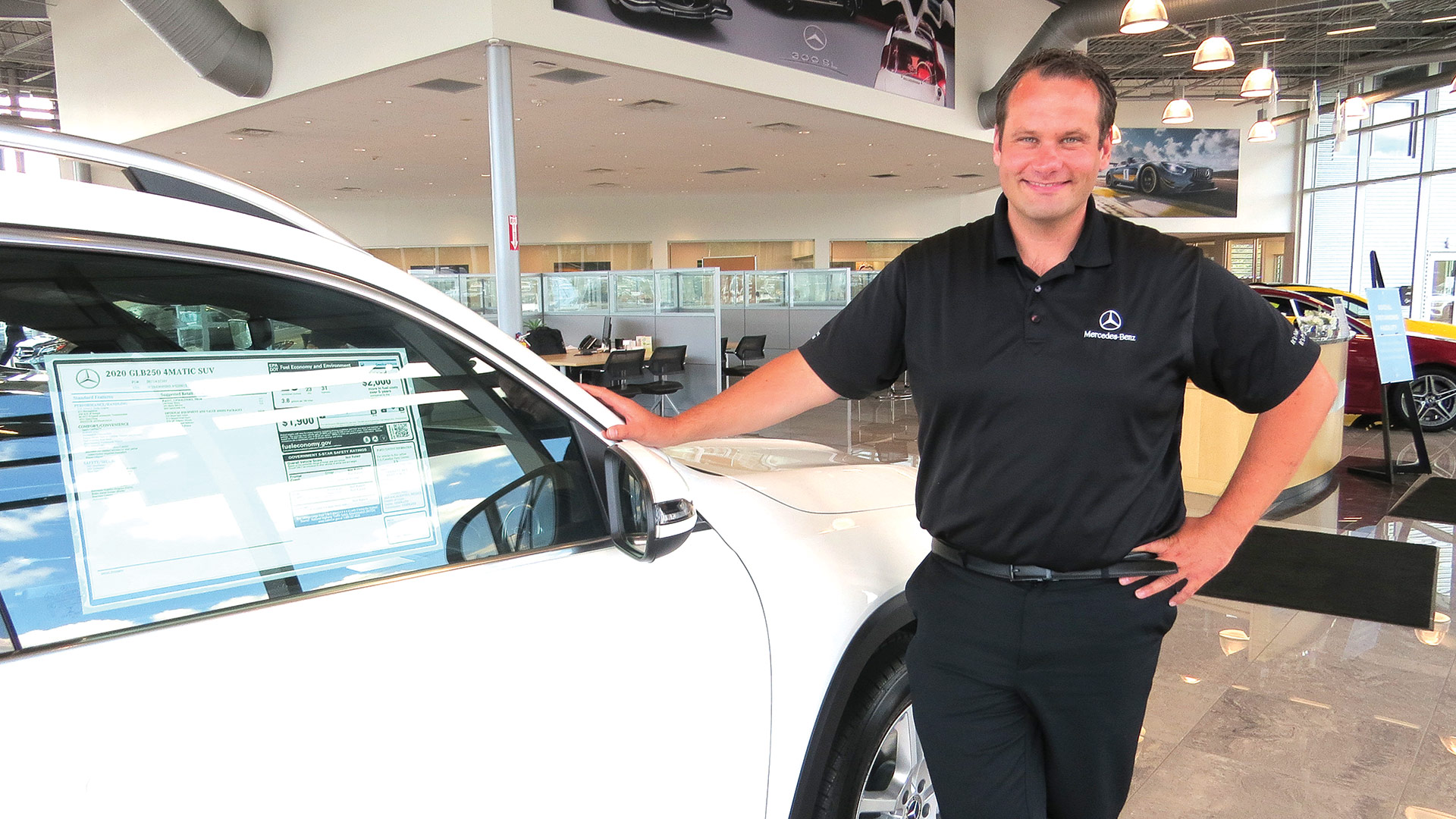In Demand

Tanya Vital-Basile with a common sight — a ‘sold’ sign.
Tanya Vital-Basile recently sold a house in Longmeadow to someone who might not have considered buying it a year ago.
But life changed — and so did the residential real-estate market. Considerably, in both cases.
Specifically, the buyer had lived in Boston for many years, and still has a job there, but she has been working remotely, and plans — like so many others these days — to continue doing so.
“She was paying $2,900 a month to rent in Boston, and here, she’s paying a $2,000 mortgage, and owning it,” said Vital-Basile, who heads a team at Executive Real Estate. “We’ve seen a lot of people moving out of Boston just because they don’t need to be out there anymore.”
It’s a story BusinessWest heard multiple times from area Realtors.
“It’s not unlike what we saw after 9/11 — a migration from the city to smaller towns and villages, a more rural environment,” said Kathy Zeamer of Jones Realty. “A lot of people today are looking for a place that gives them a little more space, private outdoor areas, home-office space, a place for their kids to do their schooling from home.”
“She was paying $2,900 a month to rent in Boston, and here, she’s paying a $2,000 mortgage, and owning it. We’ve seen a lot of people moving out of Boston just because they don’t need to be out there anymore.”
Call it the new normal wrought by a still-raging pandemic.
“COVID has a lot to do with it,” said Lesley Lambert of Park Square Realty. “People are working from home, and they’re realizing their home doesn’t work for their life. I’ve spoken to so many clients who want to continue working from home, even once all this clears, and they’re looking at their space and saying, ‘we thought we wanted a big, open floor plan, but what we actually want is a music room, a study, a home office.’”
All this demand — for a different home, but especially one far outside the metro areas — has created a serious imbalance with supply in Western Mass., creating a seller’s market like few this industry has experienced in recent decades.
“In Hampden County, the average days a house spends on the market is three. It’s crazy,” Vital-Basile said.
The most recent statistics from the Realtor Assoc. of Pioneer Valley bear this out. In December, home sales in the Pioneer Valley were up 29.2%, and median price was up 10.1%, from December 2019. Hampden County led the way (sales up 32.0% and median price up 11.5% from the previous year), but Franklin County (26% and 10.6%) and Hampshire County (20.4% and 9.1%) weren’t far behind.
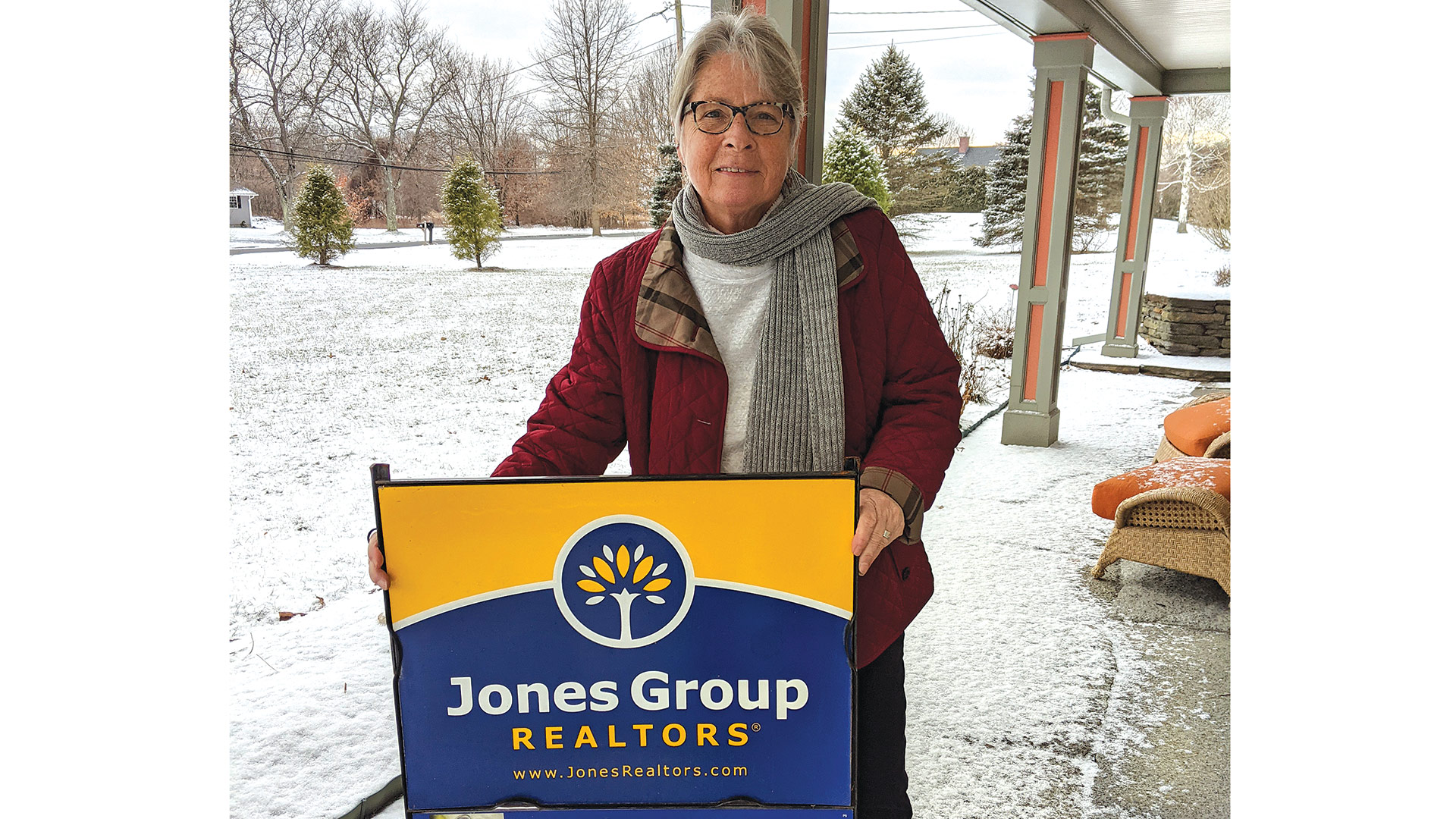
Kathy Zeamer says the current climate is a supply-and-demand issue — with several factors driving that demand.
“It’s definitely a seller’s market, Zeamer said. “It’s all about supply and demand. The inventory is really low, and we have new people coming into the area, so we don’t have enough inventory to meet the demand we’re seeing.”
A few factors play into the supply challenge. Many families who might be thinking about moving out of the region are hunkering down instead because of uncertainties related to the pandemic. Meanwhile, home buyers aren’t putting their own houses on the market until they’ve got a new home nailed down.
As for demand, “I think people are trying to escape more urban areas,” she added. “We have people coming in from other parts of Massachusetts, including the Boston area. Most of my sales this year involve people from New York, California, Las Vegas, Chicago — more so than ever before. I’ve had several New York sales this year, which is more than I would typically see.”
Escaping the City
The lifestyle shifts driven by the pandemic aren’t the only factor driving demand, Vital-Basile said, noting that interest rates are still at historic lows, creeping below 3%.
“The rates are so low that a lot of people are realizing it’s much cheaper than renting,” she told BusinessWest, adding that sellers from the Hub find they can get much more living space for their money in the Pioneer Valley.
“It’s not unlike what we saw after 9/11 — a migration from the city to smaller towns and villages, a more rural environment. A lot of people today are looking for a place that gives them a little more space, private outdoor areas, home-office space, a place for their kids to do their schooling from home.”
“We’ve had a lot of buyers from Boston. My last three sales were from Boston — cash buyers. A lot of people are realizing they don’t have to work at their company’s location any longer; a lot of companies are letting them work from home. And this is a cheaper area — instead of a little condo for $700,000, you can get a good-sized house for $700,000.”
Zeamer said she’s also seeing an increased desire for multi-generational living experiences, which typically require a larger home than the buyer currently occupies. “They might have older parents or grown children, and they need more living space or in-law apartments.”
But the main driver for more space is simply the fact that families are spending much more time at home. “Because of the pandemic, they want more space, and different types of space,” Zeamer said. “Some people are moving because they feel cooped up in their existing homes; it’s too tight with the kids being home and partners working remotely from home.”
The pandemic has also generated a desire in some people to live more sustainably — to grow more food at home, for example, instead of relying totally on grocery stores, she noted. “They want to have a nice garden, and they’re thinking more about providing their own food sources.
“And I do think people are looking for more private outdoor space, where they can gather with their people, in their pod, without exposure from the neighbors,” she went on. “A lot of condos are coming on the market, perhaps because people in close living arrangements are looking to be more isolated.”

Lesley Lambert (center, celebrating another sale) says prime properties can get dozens of offers quickly — and over the asking price.
Lambert said the Berkshires and the Northampton/Easthampton area are both notable hotspots right now, but all of Western Mass., much like Cape Cod, is being seen as an attractive alternative to life in a metroplex.
“If they want to get out of their cities, it’s a good time, as a lot of companies are going with mobile workers. I think the brick-and-mortar concept is going to take a hit, and we’ll see more people realizing they don’t have to live where they work.”
Zeamer agreed. “I think Western Mass. is really appealing to a lot of urban types of buyers,” she said, noting, as tourism boards and chambers of commerce have for generations, that this region offers an urbane, progressive mindset in many corners, plus the kinds of cultural and recreational amenities city dwellers appreciate, but in a quieter, morte scenic setting with myriad ways to enjoy the great outdoors.
And, as noted, there are more seekers of such homes right now than sellers. As an example, Lambert recalled one house she sold last fall. “It was a lovely house, not a crazy McMansion. I had 50 showings in two days, and 15 offers — all over the asking price. From what I’m hearing from my teammates and fellow Realtors, it’s like that for everybody.”
Buying Time
While that makes for an exciting home-selling experience, it can be frustrating on the other side.
“There’s so much competition that people are struggling to secure a home,” Zeamer said. “And that’s keeping them from putting their own home on the market. It’s a great time to sell, but then you have to buy, and that part is very challenging right now.”
One of her colleagues at Jones recently got 18 offers on a property, some with cash in hand. “It’s hard to compete if there’s a cash offer in the mix. In urban areas, people are liquidating properties and have lots of cash in hand, and the prices here look pretty attractive compared to what they’re used to.”
“In Hampden County, the average days a house spends on the market is three .”
Also suppressing supply is the fact that some homeowners eyeing a move simply don’t want people in their houses during the pandemic, so they’re delaying a move, Vital-Basile said. “I ask sellers, ‘what makes you comfortable? Do you want a one-time showing, an open house with three families at a time, and after that, I’ll go and clean everything?’ It depends on the client.” Meanwhile, it can be especially tricky to sell a house with tenants if those tenants don’t want visitors due to COVID-19.
“Very rarely are you seeing open houses anymore. I can’t speak for all Realtors, but I switched to doing 3D home tours, where you can sit at your desktop and ‘walk’ through the house,” Lambert said, noting that in-person walk-throughs are reserved for houses the buyer is especially interested in.
In addition, “we can’t meet with clients like we used to,” she said. “We have to do a lot more remotely, talking on a phone call of Zoom call.”
The challenges of buying a house right now — both logistical and competitive — reinforce the need to have strong representation, said all the Realtors we spoke with. And to use common sense.
For instance, Vital-Basile said, some potential buyers are waiving appraisals and inspections to get a leg up, but she doesn’t recommend that. “I tell everyone, ‘don’t force the buy; you don’t want to be in a bad situation. Even if it’s the right house at the right price, don’t force it. Always have the agent negotiate.”
Lambert is certainly an advocate for the agent-client relationship — and not just any agent. “I tell them they need the strongest buyer’s agent they can find, and not just work with your cousin because he got his license six months ago. Sometimes that’s fine, but in this market, you have to know what you’re doing.”
That includes securing preapprovals and discussing beforehand what a competitive offer should looks like. “If the first time you talk to a buyer is when the boots are hitting the road, they’re going to freak out. It’s got to be a strategy you’ve developed with them regardless of the house they find.”
And it means, in many cases these days, being prepared to offer more than the asking price right off the bat, before someone else invariably does.
“I have a team of trusted affiliates who take great care of my clients, and when my clients listen to my well-erned advice, we have smooth sailing,” Lambert said. “I’m not the only realty team like that, of course. But it’s important to have advocates on your side right now.”
That said, the “crazy prices” sellers are getting don’t seem to be slowing up, Vital-Basile said. “I don’t think the market will tank anytime soon,” she said. “But a $180,000 house going for $275,000 … it can’t continue this way, or else the average homeowner won’t be able to afford a mortgage, and then the market will have to stabilize. Right now, though, there are too many buyers out there, ready to move.”
Joseph Bednar can be reached at [email protected]



